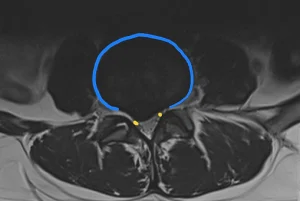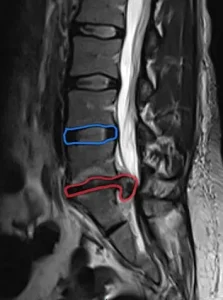Understanding Disc Prolapse (Sciatica):
When the Car Gets Stuck
The terms sciatica, slipped disc, or disc bulge are frequently used to describe a common condition. Fortunately, most individuals recover within six to twelve weeks with appropriate management. Patients often describe it as if their sciatic nerve is trapped, causing shooting leg pain. However, it’s important to note that the sciatic nerve, like cars on a motorway (Read Spinal Motorways), isn’t trapped; instead, the condition manifests as the classic radicular shooting leg pain.


MRI scan of lumbar spine illustrating disc prolapse from the side and top. The normal disc (outlined in blue) maintains it height and the prolapsed disc (outlined in red) has bulged into the canal or the superhighway. In the motorway’s view the car (yellow outlined) appears to be pushed against the hard shoulder by the bulging disc.
Common Symptoms
The majority of patients present with shooting leg pain symptoms (as described earlier, see About Spine Symptoms). However, some may experience both back and leg pain due to age-related changes in the disc. These symptoms can be exacerbated by coughing and sneezing.
Is This Cause for Concern?
In most cases, these symptoms improve with appropriate pain management and physiotherapy. The initial treatment goal is pain control and preventing progressive neurological damage (e.g., weakness). This is typically achieved through painkillers and targeted physiotherapy. Alternative therapies such as yoga, Pilates, acupuncture, and chiropractic therapy can also be explored.
Duration of Non-Operative Treatment
The duration of non-operative treatment varies individually. Generally, treatment plans must be weighed against potential risks. The goal should be to minimize risks while maximizing benefits. This can vary among individuals and must be tailored to each patient’s goals. Discuss this with your treating clinician to make an informed decision. Prolonged unaddressed symptoms can lead to chronic pain.
When Surgery Is Considered
Certain conditions require discussion about surgery, including Cauda Equina Syndrome, weakness, and failure of conservative approaches to manage pain. In such situations, further management plans are essential. Options may include:
Steroid Injection: Under image guidance (commonly X-ray), a mixture of local anesthesia and steroids is injected around the nerve root to alleviate leg pain.
Microdiscectomy: A procedure to clear the motorway by shaving the disc, allowing the nerve to flow freely. This is performed under general anesthesia as a same-day or overnight stay procedure.
Endoscopic (Keyhole) Surgery: Performed with a less than 1 cm stab wound using high-end technology, similar to knee and shoulder procedures. This minimally invasive approach facilitates early recovery.
Other Conditions to Consider
Radicular leg pain can be mimicked by hip, knee, and ankle issues (see Referred Pain), problems with leg blood supply, sacroiliac joint pain, peripheral nerve problems, and more. Seeking medical advice is crucial for proper diagnosis.
Cauda Equina Syndrome
Cauda equina syndrome is a rare but considered a surgical emergency. It presents a combination of symptoms, including back pain, leg pain, weakness, and bladder/bowel symptoms. Immediate medical attention is needed as it affects the nerves supplying the bladder and bowel. Early surgical intervention is essential for better outcomes. (See MRI scan illustration for reference)


MRI scan of lumbar spine illustrating disc prolapse from the side and top. The normal disc (outlined in blue) maintains it height and the prolapsed disc (outlined in red) has bulged into the canal or the superhighway. In the motorway’s view the car (yellow outlined) appears to be pushed against the hard shoulder by the bulging disc.
Understanding disc prolapse helps in better management and informed decision-making.
Empower yourself with knowledge to make informed decisions regarding your health and well-being. For further guidance, assessment, and expert care, don’t hesitate to contact us today
Note: Medical conditions should always be discussed with a qualified healthcare professional. This content is for informational purposes only.
